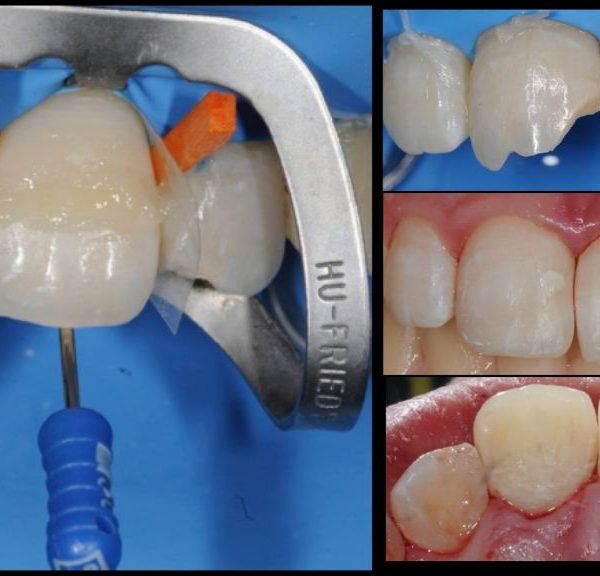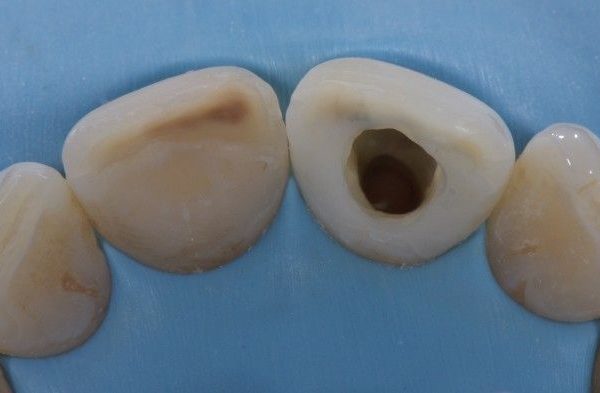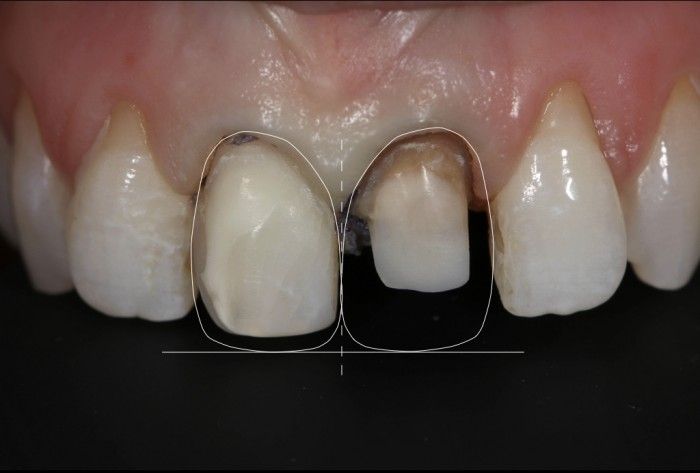
Metal Post and Core, How to Improve Aesthetics
13/06/2017
The Community
Warning: Undefined variable $post in /var/www/vhosts/styleitaliano-endodontics.org/endodontics.styleitaliano.org/wp-content/plugins/oxygen/component-framework/components/classes/code-block.class.php(133) : eval()'d code on line 2
Warning: Attempt to read property "ID" on null in /var/www/vhosts/styleitaliano-endodontics.org/endodontics.styleitaliano.org/wp-content/plugins/oxygen/component-framework/components/classes/code-block.class.php(133) : eval()'d code on line 2
In the last century, cast metal post represented the method of choice in the philosophy of root canal tooth reconstruction. The procedure usually involved the use of a porcelain fused to metal crown, but in the 1990s full porcelain crowns started to replace the metal base crowns and the problem of how to hide severe tooth discolourations or metal posts arose.
The era of microscopes and ultrasonic devices in endodontics brought the possibility of metal post removal, which may be rational in the event that retreatment is necessary, but can be very risky in terms of dental tissue loss.
There are several indications and contraindications of metal post removal, which are summarised in Img. 1, but the most important rule today should be the preservation of the coronal and radicular tooth structure, which is essential for the long-term success of endodontically treated teeth.
Case Study
A female patient reported in the dental office in order to improve her smile because she did not like her left upper central incisor that had been restored with a porcelain crown (Img. 2, 3). The colour and shape of the crown did not match the neighboring teeth. DSD analysis revealed a discrepancy between the midline of the two central upper incisors and the vertical reference line - the face midline (Img. 4, 5).
Functional analysis was performed, and after four weeks of Kois Deprogrammer application, the premature occlusal contacts were removed and stabile bilateral occlusion was confirmed.
Based on DSD analysis, the mock-up procedure was carried out and it was decided that the best solution would be to change the shape of both upper central incisors and to correct the midline between teeth 11 and 22. The patient refused the orthodontic option, and we decided to carry out two restorations: a crown in tooth 21 and veneer in tooth 11, both from the same ceramic material - lithium disilicate.
The color of tooth 21, previously restored with a metal post, posed a potential problem.
The periapical and endodontic status of tooth 21 were acceptable (Img. 6), and there was no need for retreatment. The removal of the metal post and replacement with a fiber post could be aesthetically beneficial, but could compromise the remaining dentin and create a structural risk for future restoration. Therefore, the complicated procedure of metal post removal for purely aesthetic reasons was not indicated.
Instead, an opaque layer of composite material was planned to be placed over the buccally reduced cast core in order to decrease the light absorption and increase the reflectance of the metal. The desired effect was to raise the value of the core in order to approach the visual qualities of dentin. This allows more depth and translucence of the crown, as light penetrates further into it.
The PFM crown was removed from tooth 21 (Img. 7-9), and after rubber dam isolation the buccal 0.5 mm of the metal post was removed (Img. 10). This procedure can be easily done with an Amalgam Remover H32 (Komet) drill or diamond drill suitable for crown preparation.
Then, the metal post was sand-blasted (AquaCare Dental Air Abrasion) with 53 micron aluminium oxide particles (proCut, Coarse Cutting Powder) (Img 11)and the three functional monomers (4-MET, MDP and MDTP) adhesive system (G-Premio Bond, GC) was applied on the metal core and supra-gingival tooth structure in order to provide adhesion to both the dentin and the metal.
Next, the metal surface was covered by two thin layers of opaque composite resin (Essentia Masking Liner, GC), followed by a soft viscosity composite dentin layer (Essentia MD, GC) with the use of a brush in order to create a masking thickness of 0.5 mm in total. The last layer was placed with a little overextension on the remaining tooth structure (Img. 12).
The pre-prepared shell crown (polymethyl methacrylate, Unifast Trad; GC) was then adjusted and relined directly on the tooth abutment (Img. 13-15).
The final preparation and impression taking was postponed for one month later and in meantime the teeth bleaching was obtained in the lower and upper arch (6% Hydrogen Peroxide, White Dental Beauty, Optident)
The silicon index was prepared based on the wax-up. At the next appointment, the minimal veneer preparation and final crown preparation were carried out, followed by impressions and face-bow registration (Img. 16-20).
The dental technician prepared two lithium disilicate ceramic restorations (E-Max, Ivoclar), which were cemented with dual-cure adhesive luting cement (G-CEM LinkForce, GC) (Img. 21-24). First, the porcelain veneer was cemented in rubber dam isolation (Img. 25) Then, after adequate light-curing and the removal of excess cement, the porcelain crown was double checked for proper fitting before being cemented into its final position (Img. 26, 27).

Fig. 1
Indications and contraindications of metal post removal.

Fig. 2
A female patient reported in the dental office in order to improve her smile.

Fig. 3
The patient did not like her right upper central incisor that had been restored with a porcelain crown.
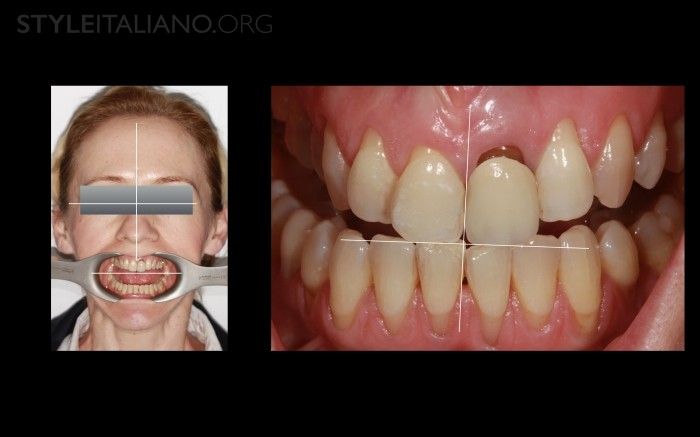
Fig. 4
DSD analysis revealed a discrepancy between the midline of the two central upper incisors and the vertical reference line - the face midline.
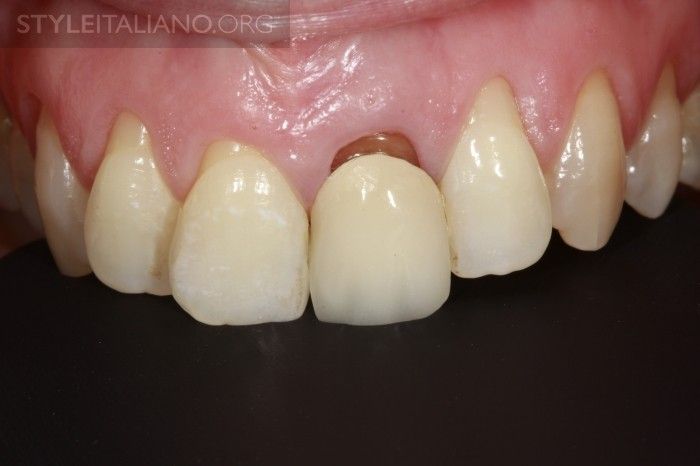
Fig. 5
The clinical view on tooth 21 restored with cast metal post and PFM crown.
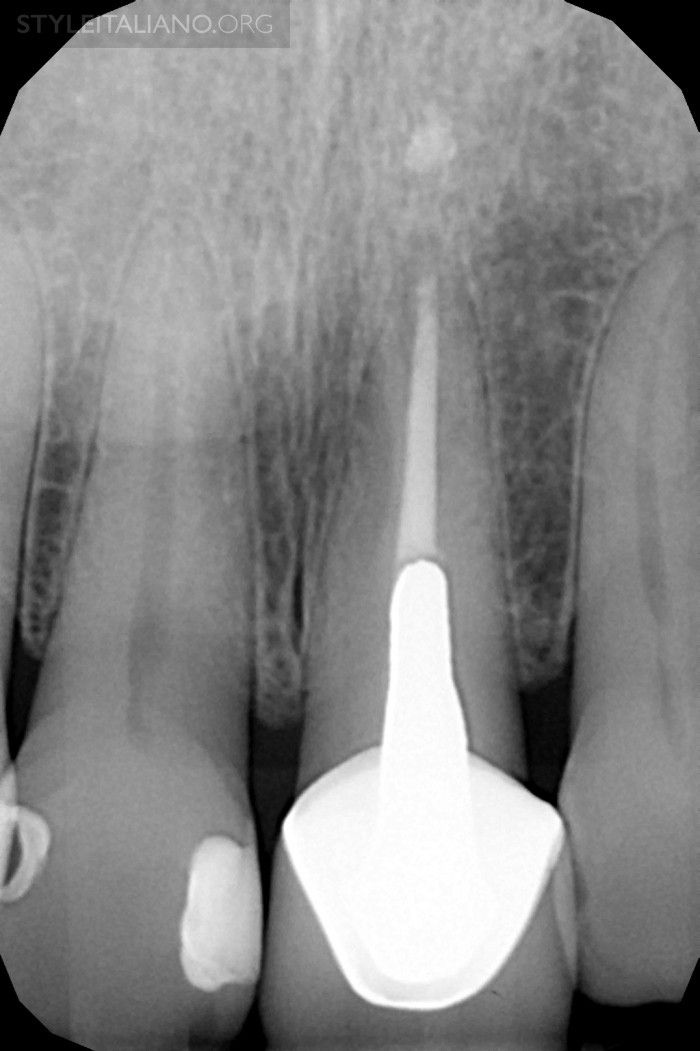
Fig. 6
X-ray of the endodontically treated tooth 21.

Fig. 7
The crown was sectioned and removed.

Fig. 8
The crown was sectioned and removed.

Fig. 9
The clinical view on tooth 21 restored with cast metal post.

Fig. 10
After rubber dam isolation, the buccal 0.5 mm of the metal post was removed.

Fig. 11
Then, the metal post was sand-blasted (AquaCare Dental Air Abrasion) with 53 micron aluminium oxide particles (proCut, Coarse Cutting Powder).

Fig. 12
The three functional monomer (4-MET, MDP and MDTP) adhesive system (G-Premio Bond, GC) was applied. Next, the metal surface was covered with two thin layers of opaque composite resin (Essentia Masking Liner, GC), followed by a soft viscosity composite dentin layer (Essentia MD, GC) with the use of a brush in order to create a masking thickness of 0.5 mm in total.

Fig. 13
The pre-prepared shell crown (polymethyl methacrylate, Unifast Trad; GC) was then adjusted.

Fig. 14
And relined directly on the tooth abutment.

Fig. 15
The relined crown needs to be adjusted, finished and polished.

Fig. 16
The temporary crown was cemented and the preliminary color check for the final ceramic work was made. The final preparation and impression taking was postponed for one month later, and, in meantime, the teeth bleaching was obtained in the lower and upper arch (6% Hydrogen Peroxide, White Dental Beauty, Optident).

Fig. 17
The minimal veneer preparation and final crown preparation were carried out.

Fig. 18
The preparation was carried out under the control of sectioned silicone index.

Fig. 19
The view on final preparation.

Fig. 20
In order to verify the final preparation with reference to the face symmetry, additional photos were taken and reference lines drawn in MS Power Point software.

Fig. 21
The etching procedure for tooth 11 was carried out under rubber dam isolation.

Fig. 22
As well as the adhesive procedure.

Fig. 23
The view on two ceramic restorations after laboratory fabrication.

Fig. 24
The porcelain was cemented with a dual-cure adhesive luting cement (G-CEM LinkForce, GC).

Fig. 25
Then, after the removal of excess cement, the porcelain crown was double-checked for proper fitting before being cemented into its final position.

Fig. 26
The clinical view, immediately after cementation.

Fig. 27
The final profile view of the upper central incisors restored with ceramic restorations.
Conclusions
Masking the existing metal cores with opaquer layer of composite material improves the aesthetics of final full ceramic restorations.
The masking procedure serves to preserve coronal and radicular tooth structure, which is essential for long-term success of endodontically treated teeth.
Bibliography
1. Fradeani M, Aquilano A, Barducci G. Aesthetic restoration of endodontically treated teeth. Pract Periodontics Aesthet Dent. 1999 Sep;11(7):761-8;
2. Zarow M, Nizankowska-Jedrzejczyk A. Solving esthetic problems of coronoradicular metal posts in anterior teeth. Case report. Ann Acad Med Stetin. 2009;55(1):84-9.
3. Volpato CA, Monteiro S Jr, de Andrada MC, Fredel MC, Petter CO. Optical influence of the type of illuminant, substrates and thickness of ceramic materials. Dent Mater. 2009 Jan;25(1):87-93.
4. Zarow M. Nonvital Tooth Bleaching: A Case Discussion for the Clinical Practice. Compend Contin Educ Dent. 2016 Apr;37(4):268-76.
5. Manauta J, Salat A, Putignano A, Devoto W, Paolone G, Hardan LS. Stratification in anterior teeth using one dentine shade and a predefined thickness of enamel: a new concept in composite layering--Part I. Odontostomatol Trop. 2014 Jun;37(146):5-16.
6. Zarow M, Darcangelo C, Paolone G, Felipe L, Paniz G: EndoProsthodontics: A Guide for Practicing Dentists; Quintessence Books , 2017 (English Edition)


